How we mastered the vacuum magnetron sputtering of films
Hello, friends.
Since we have passed a relatively completed stage in the development of the technology of vacuum deposition of thin films, I logically had the idea to share my experience with you. Of course, it may seem to you that there was little that lay at the very forefront of science and technology in this movement. However, in our opinion, the experience gained may be useful.

So, the story began a little earlier, when we got a vacuum chamber. Her path to us was not close and can be described in a separate story, but this, as they say, is "a completely different story." I can only say that even earlier it brought people some benefit in one of the laboratories of the University of Gottingen.
The first thing we started to operate the vacuum chamber on was the testing of a method of thermal deposition of metals on substrates. The method is simple and old as the world. A molybdenum crucible is used to place a target of a sprayed metal, such as silver. Around it is a heating element. We used a tungsten-frien alloy wire, which was wound in the form of a spiral.
The complete device for thermal spraying is as follows:

Equipment for thermal spraying of metals. but. Assembled (protective shield and valve removed). Designations: 1 - crucible, 2 - heating element, 3 - steam pipe, 4 - current lead, 5 - thermocouple, 6 - frame for the sample.
After passing the current (it goes through the pressure glands to the vacuum chamber), the spiral heats up, heats the boat, in which the target material is also heated and evaporates. A cloud of metal vapor rises through the steam line and envelops the body onto which it is necessary to deposit a metal film.
The method itself is simple and good, but there are also disadvantages: high energy consumption, it is difficult to place surfaces (bodies) in the cloud on which the film needs to be deposited. Adhesion is also not the best. They were applied to various materials, including metals, glass, plastic, etc. Mostly for research purposes, since we only mastered vacuum equipment.
Now it’s the turn to talk about the vacuum system. We conducted the experiments in a vacuum chamber equipped with a vacuum system consisting of a rotary fore-vacuum and turbomolecular pump and providing a residual pressure of 9.5 • 10 -6 - 1.2 • 10 -5 mm Hg.
If at first glance it seems that it is not complicated, then in fact it is not. First, the chamber itself must have the tightness necessary to maintain a high vacuum. This is achieved by sealing all functional flanges and holes. The upper and lower flange-covers have the same, in principle, rubber seals, as well as the smallest openings, designed to install windows, sensors, devices, pressure glands and other flange covers, only with a diameter much larger. For example, to reliably seal such a hole, a

flange, gasket, and fasteners are required, as in this photo.
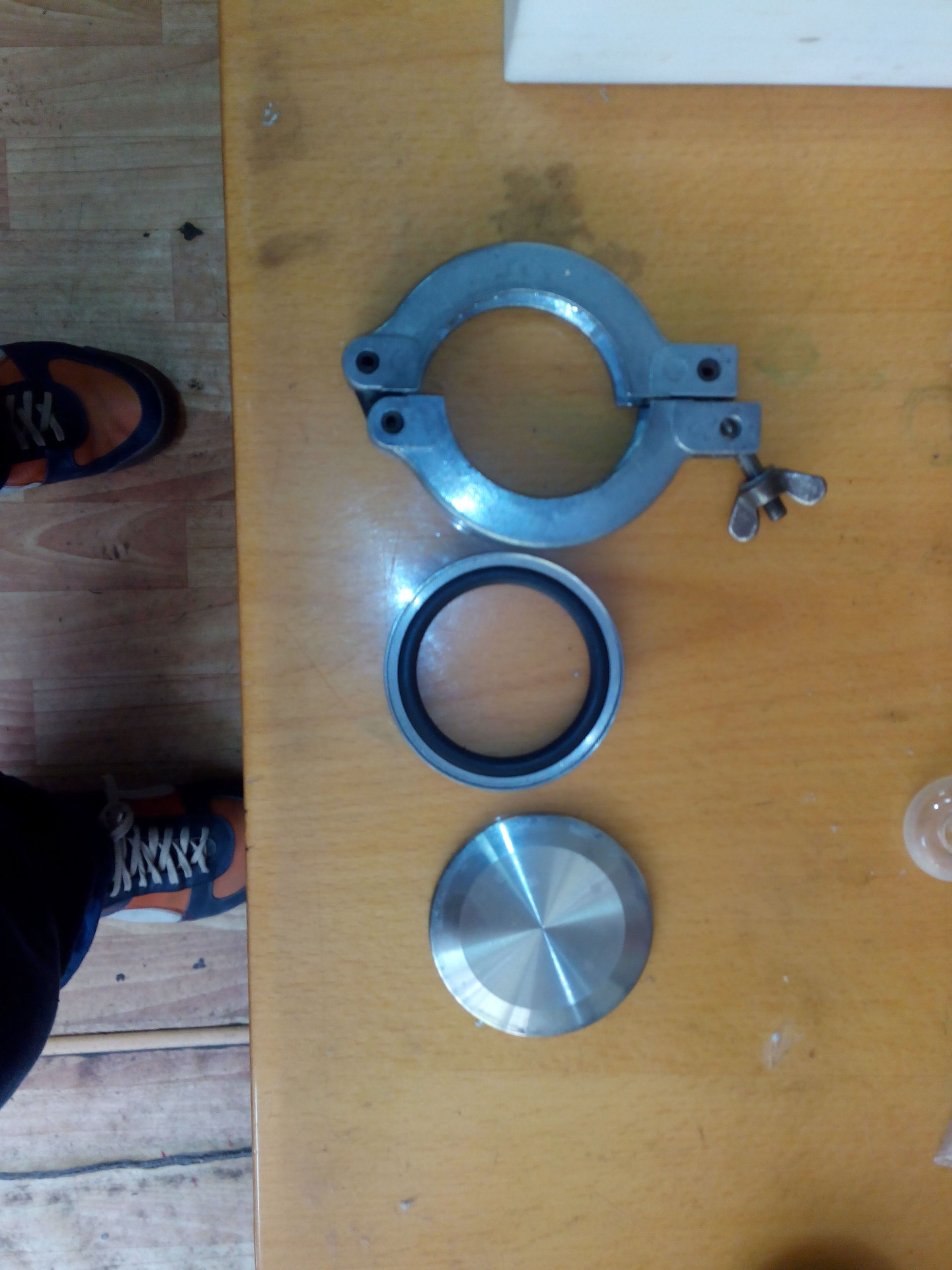
Here, this sensor measures the vacuum in the chamber, the signal from it enters the device, which shows the level of high vacuum.
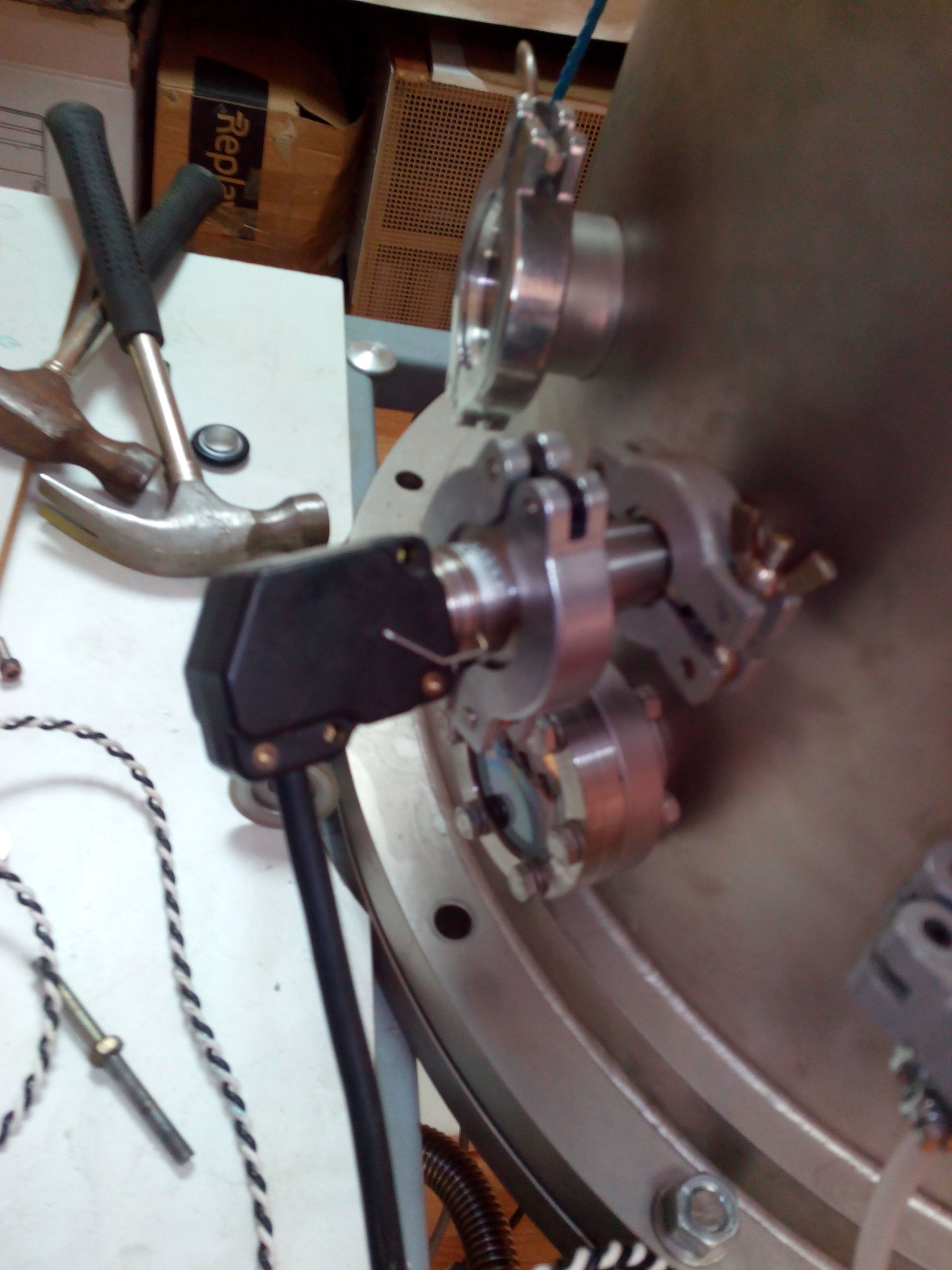
A vacuum of the required level (for example, 10-5 mmHg) is achieved as follows. Initially, a low vacuum is pumped out to the level of 10-2 by the forevacuum pump. Upon reaching this level, a high-vacuum pump (turbomolecular) is turned on, the rotor of which can rotate at a speed of 40,000 rpm. At the same time, the fore-vacuum pump continues to work - it pumps out pressure from the turbomolecular pump itself. The latter is a rather capricious aggregate and its “thin” device played a certain role in this story. We use Osaka vacuum Japanese turbomolecular pump.
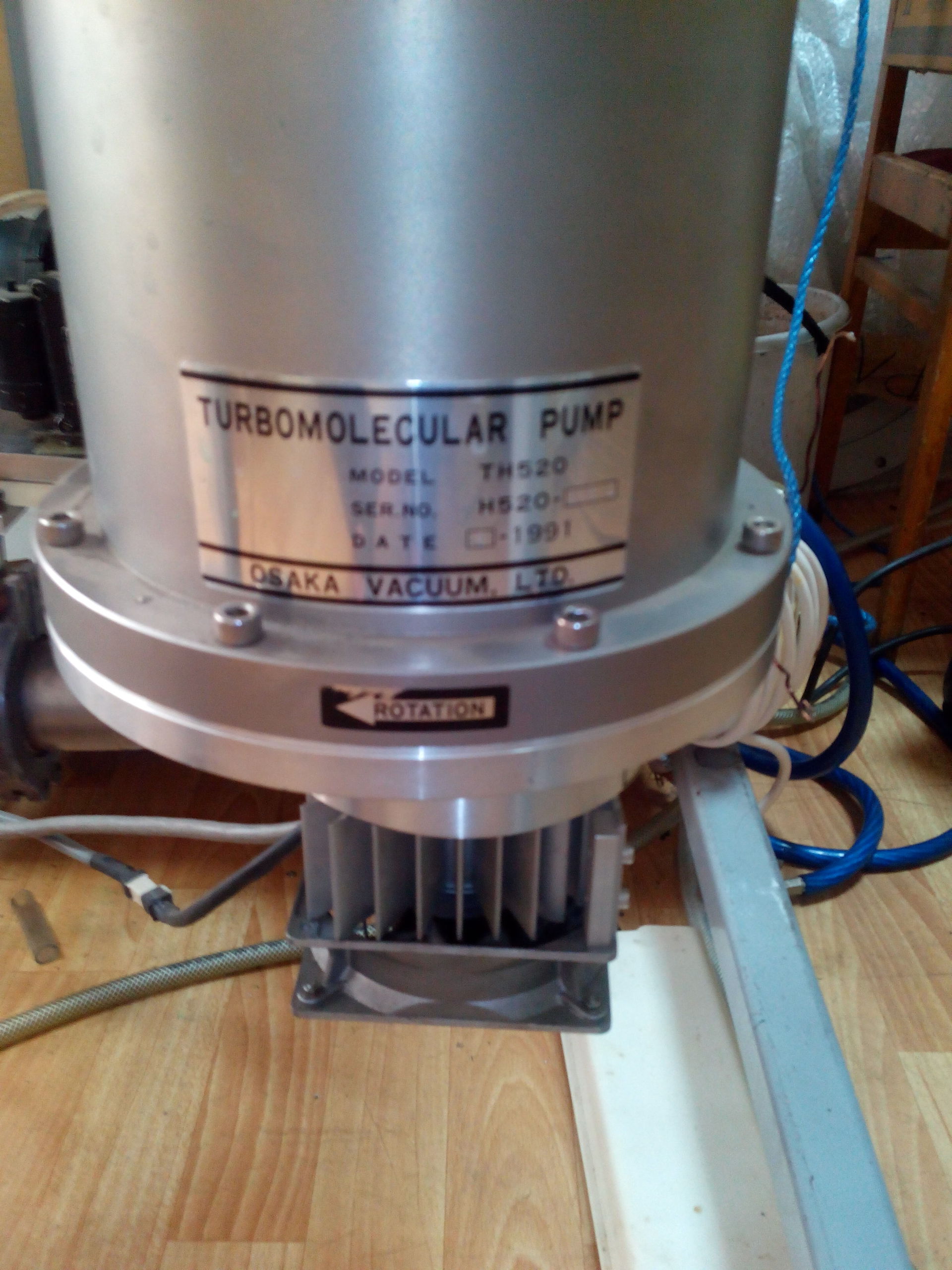
It is recommended that air pumped out of the chamber with oil vapors be discharged into the atmosphere, as fine droplets of oil can “splash” the entire room.
Having dealt with the vacuum system and having worked out thermal spraying, we decided to try out another way of applying films - magnetron. We had a long experience in communicating with one large laboratory, which applied functional nanocoatings for some of our developments, just by the method of magnetron sputtering. In addition, we have fairly close ties with some departments of MEPhI, MVTU and other universities, which also helped us master this technology.
But over time, we wanted to use more opportunities that the vacuum chamber provides.
Soon we had a small magnetron, which we decided to adapt for applying films.
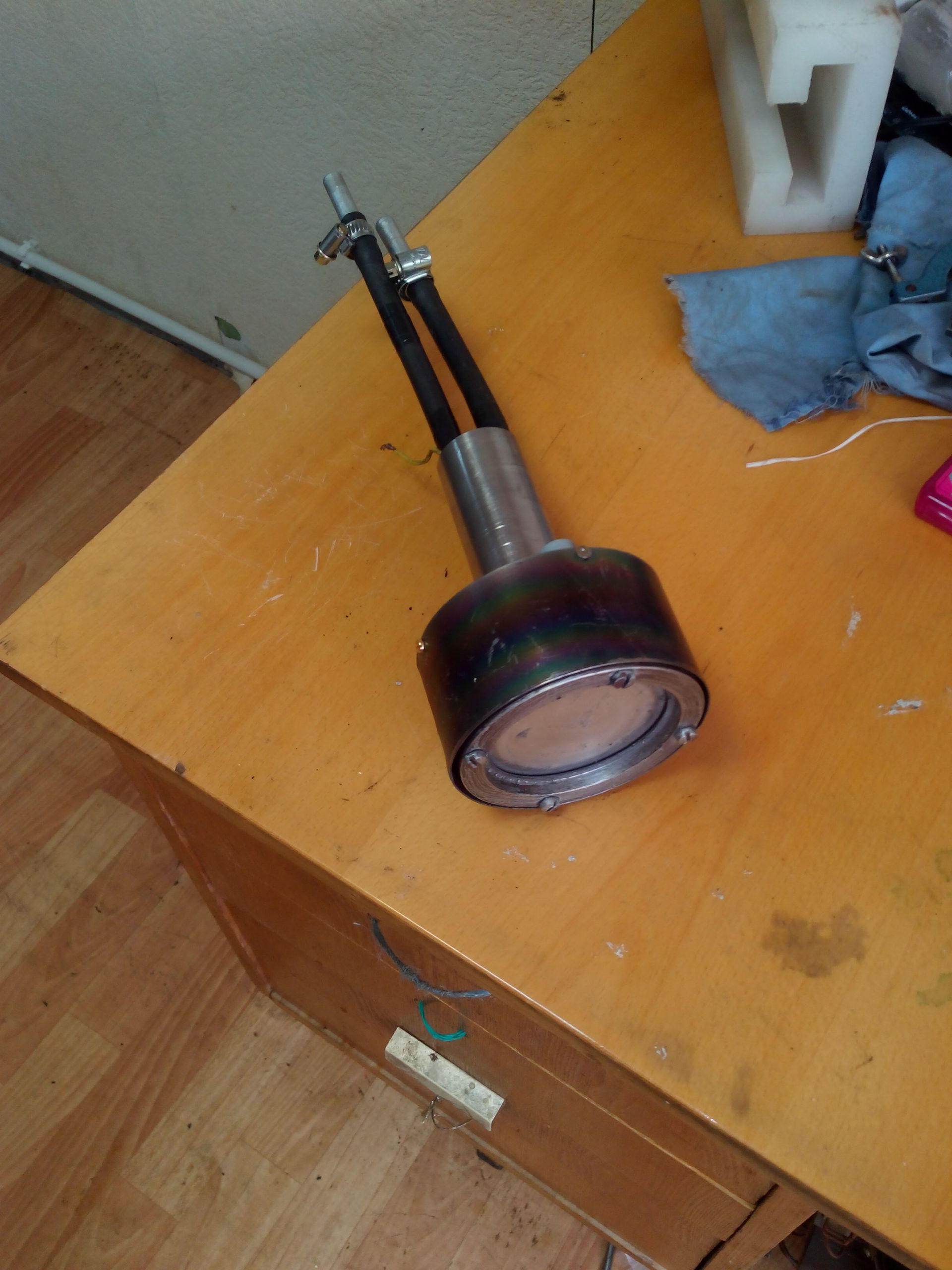
It is the magnetron vacuum method of deposition of thin metal and ceramic films that is considered one of the most productive, economical and easy to use among all physical methods of deposition: thermal evaporation, magnetron, ion, laser, electron beam. The magnetron is mounted in one of the flanges, as convenient for use. However, this is not enough for spraying, since it requires the supply of a certain voltage, cooling water, and also gases to ensure ignition of the plasma.
Simplified, the magnetron is arranged as follows. On the base, which simultaneously serves as a magnetic circuit, strong magnets are placed that form a strong magnetic field. On the other hand, the magnets are closed by a metal plate, which serves as a source of atomized material and is called a target. Potential is supplied to the magnetron, and earth is supplied to the body of the vacuum chamber. The potential difference formed between the magnetron and the camera body under conditions of a rarefied atmosphere and magnetic field leads to the following. The atom of a plasma-forming argon gas enters the action of the lines of force of the magnetic and electric fields and ionizes under their action. A knocked out electron is attracted to the camera body. A positive ion is attracted to the magnetron target and, having accelerated under the action of magnetic field lines, hits the target, knocking out a particle from it. It flies at an angle opposite to that at which the ion of the argon atom hit the target. A metal particle flies from the target towards the substrate located opposite it, which can be made of any material.
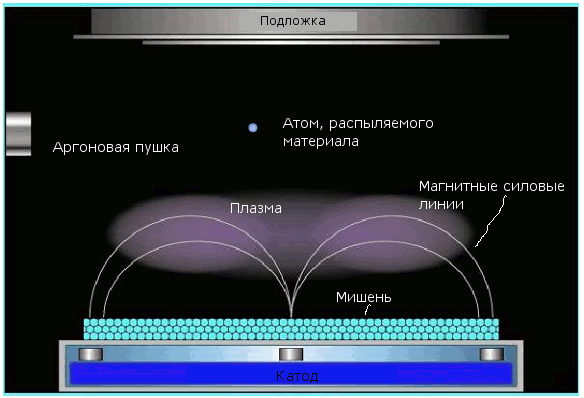
Our university friends manufactured a power source for this DC magnetron with a power of about 500 watts.

We also built a gas inlet system for plasma-forming argon gas.
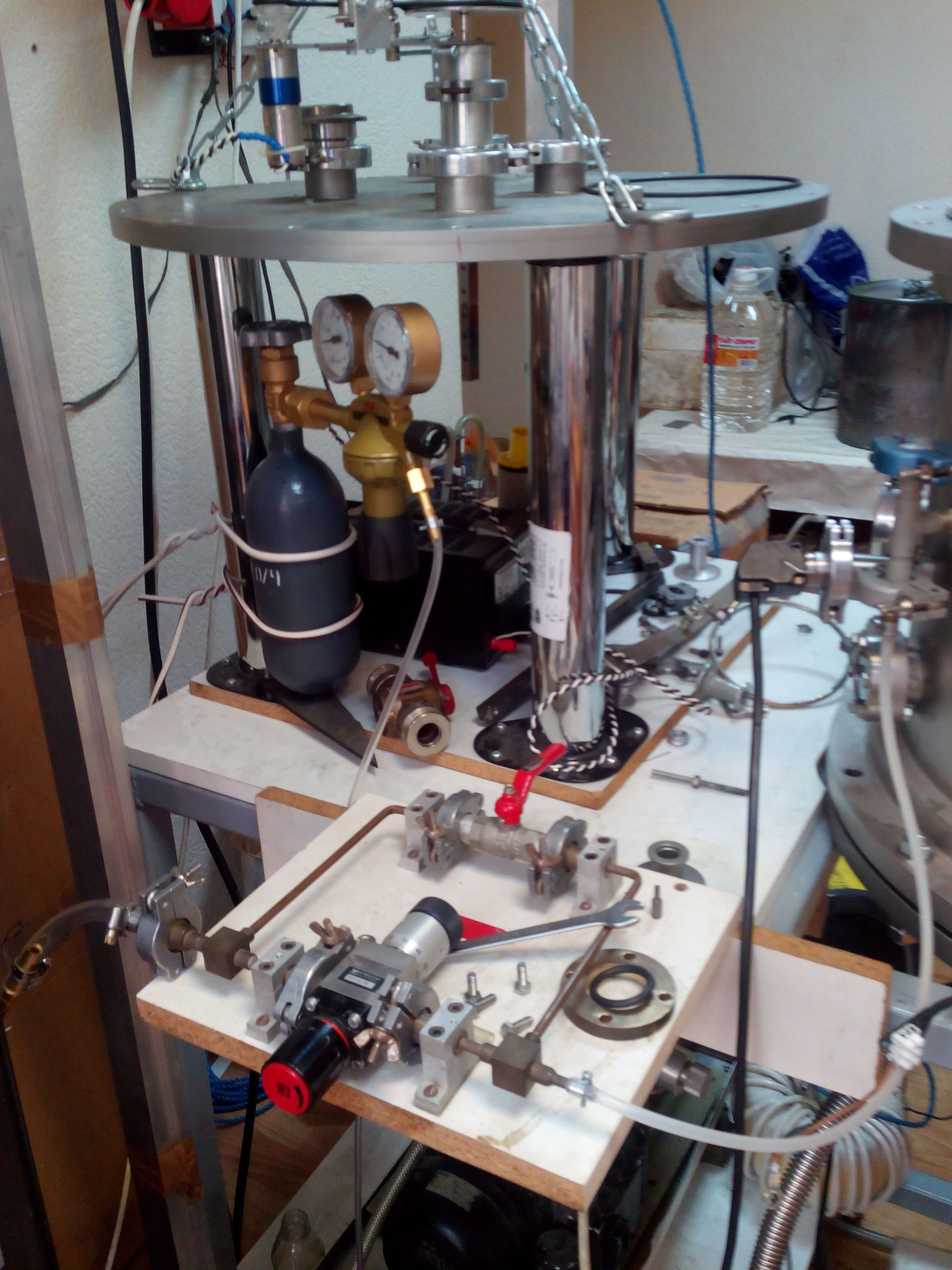
To place the objects on which the films will be sprayed, we built the following device. There are technological holes in the chamber lid in which various devices can be installed: power pressure glands, motion pressure glands, transparent windows, sensors, etc. In one of these holes we installed a rotary shaft pressure seal. Outside of the camera, we brought rotation from a small electric motor to this shaft. Having established the rotation speed of the drum of the order of 2-5 hertz, we have achieved good uniformity in the deposition of films around the circumference of the drum.
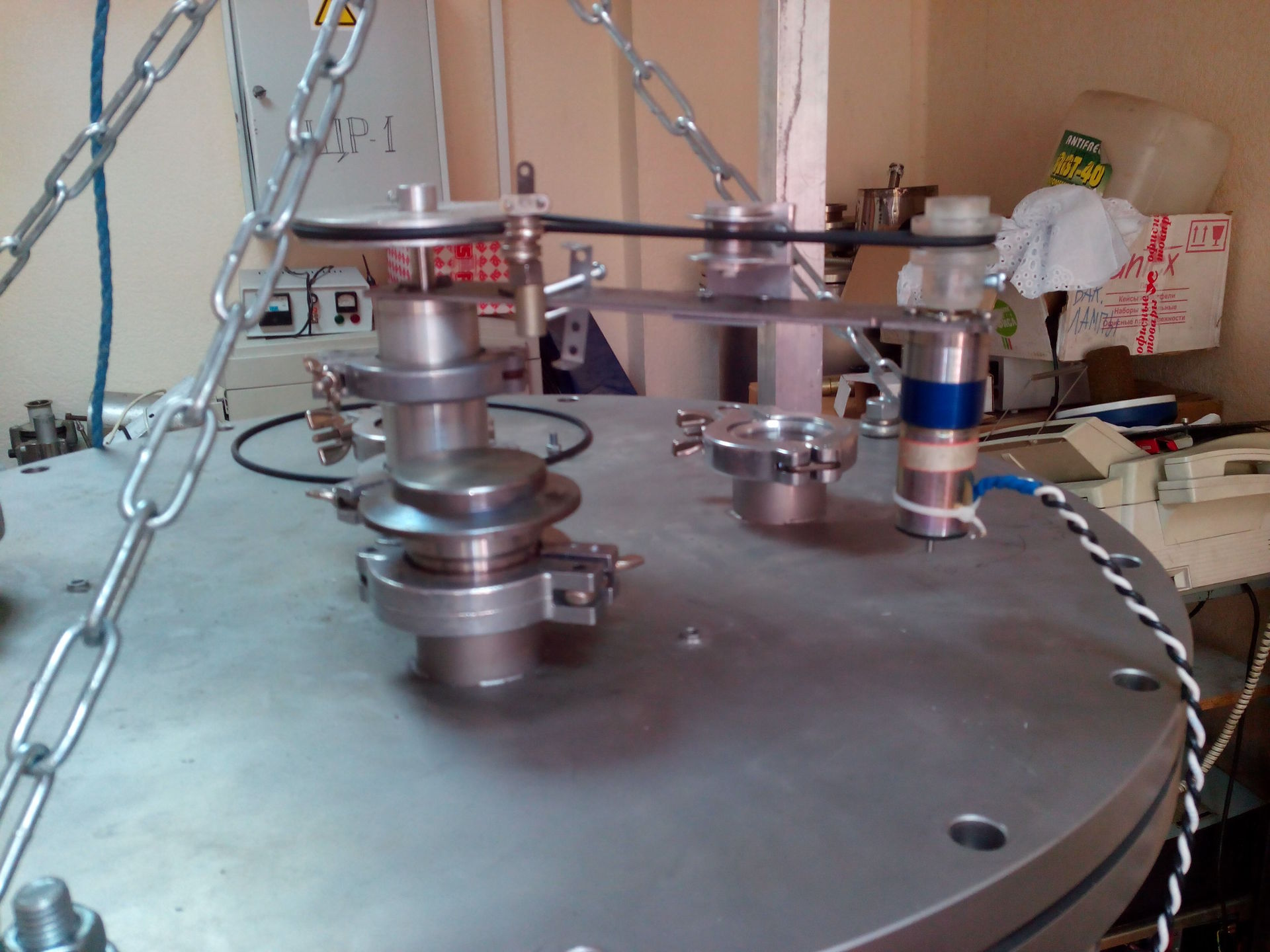
Bottom, i.e. inside the chamber, we mounted on the shaft a light metal basket on which objects can be hung. In a stationery store, such a standard drum is sold as a waste basket and costs about 100 rubles.
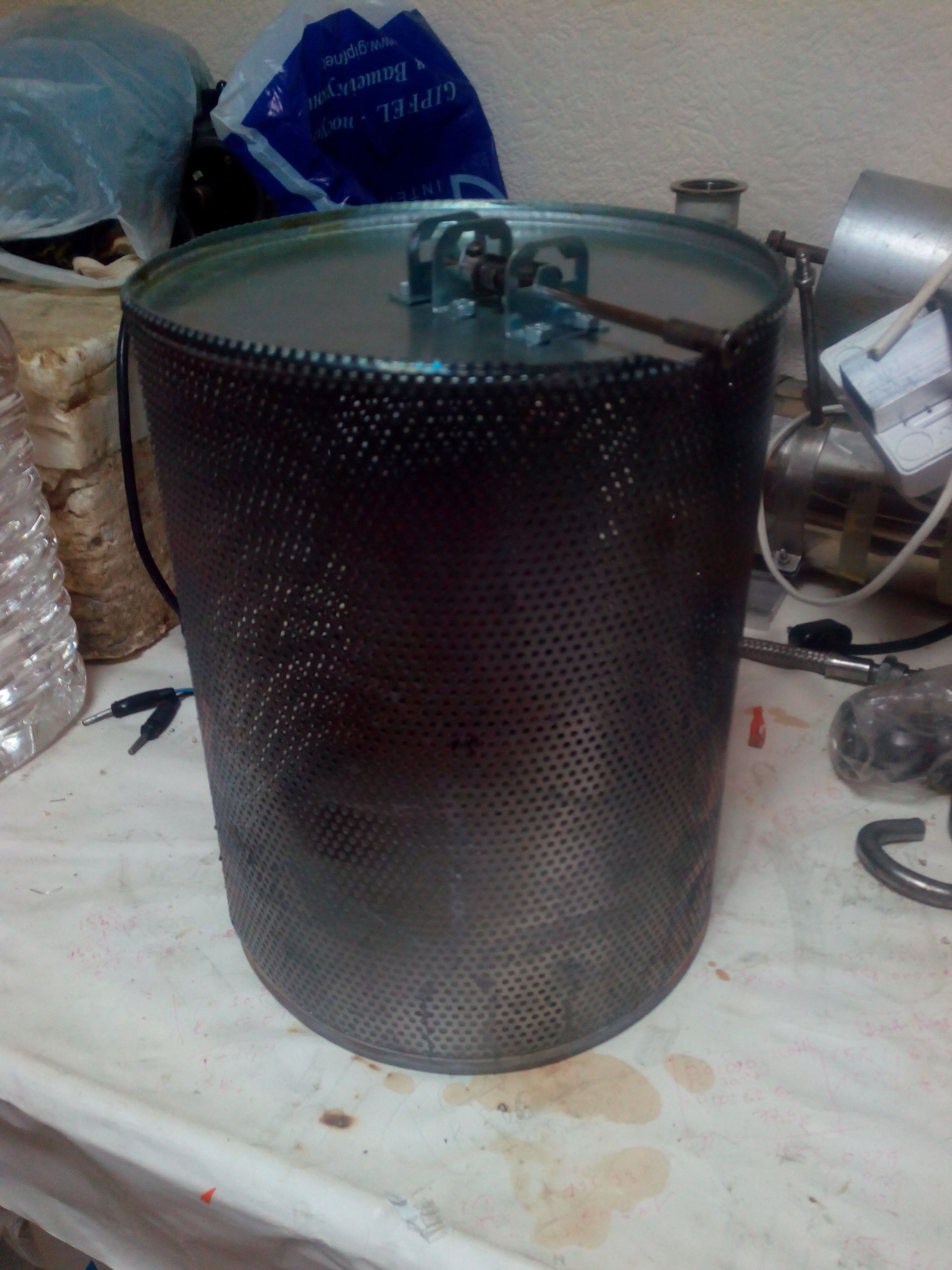
Now we had almost everything we needed for spraying films. As targets we used the following metals: copper, titanium, stainless steel, aluminum, copper-chromium alloy.
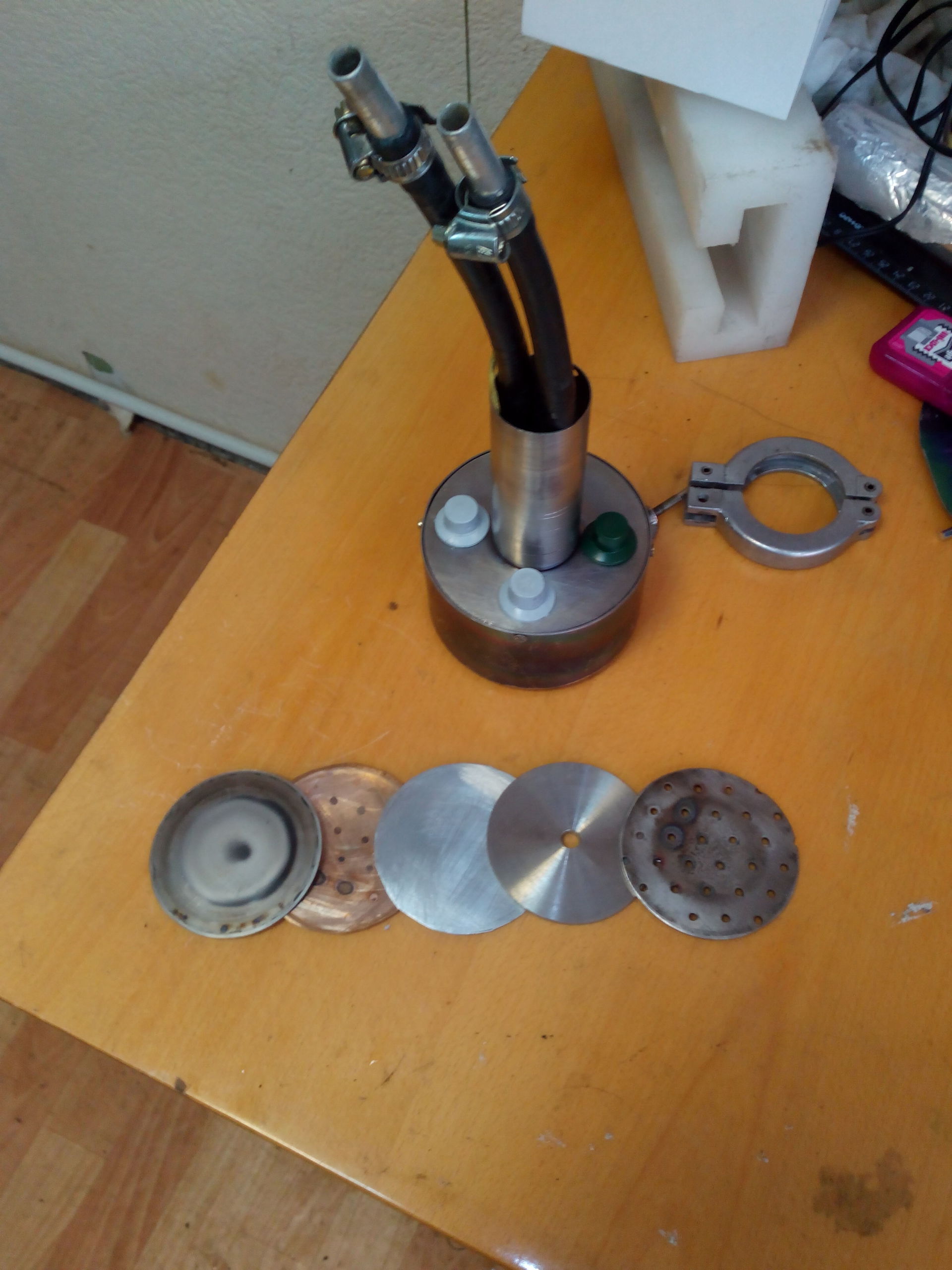
And they began to dust. Through transparent windows into the chamber, one could observe the glow of plasma on the surface of the magnetron target. So we controlled “by eye” the moment of ignition of the plasma and the intensity of the deposition.

A method for controlling the thickness of the spraying was invented quite simple. The same piece of foil with a measured surface area was placed on the drum and its weight was measured before and after the spraying session. Knowing the density of the sprayed metal, the thickness of the applied coating was easily calculated. The thickness of the coating was controlled either by changing the spraying time, or by adjusting the voltage at the magnetron's power source. This photo shows precision scales that allow you to measure the mass of samples with an accuracy of ten thousandths of a gram.
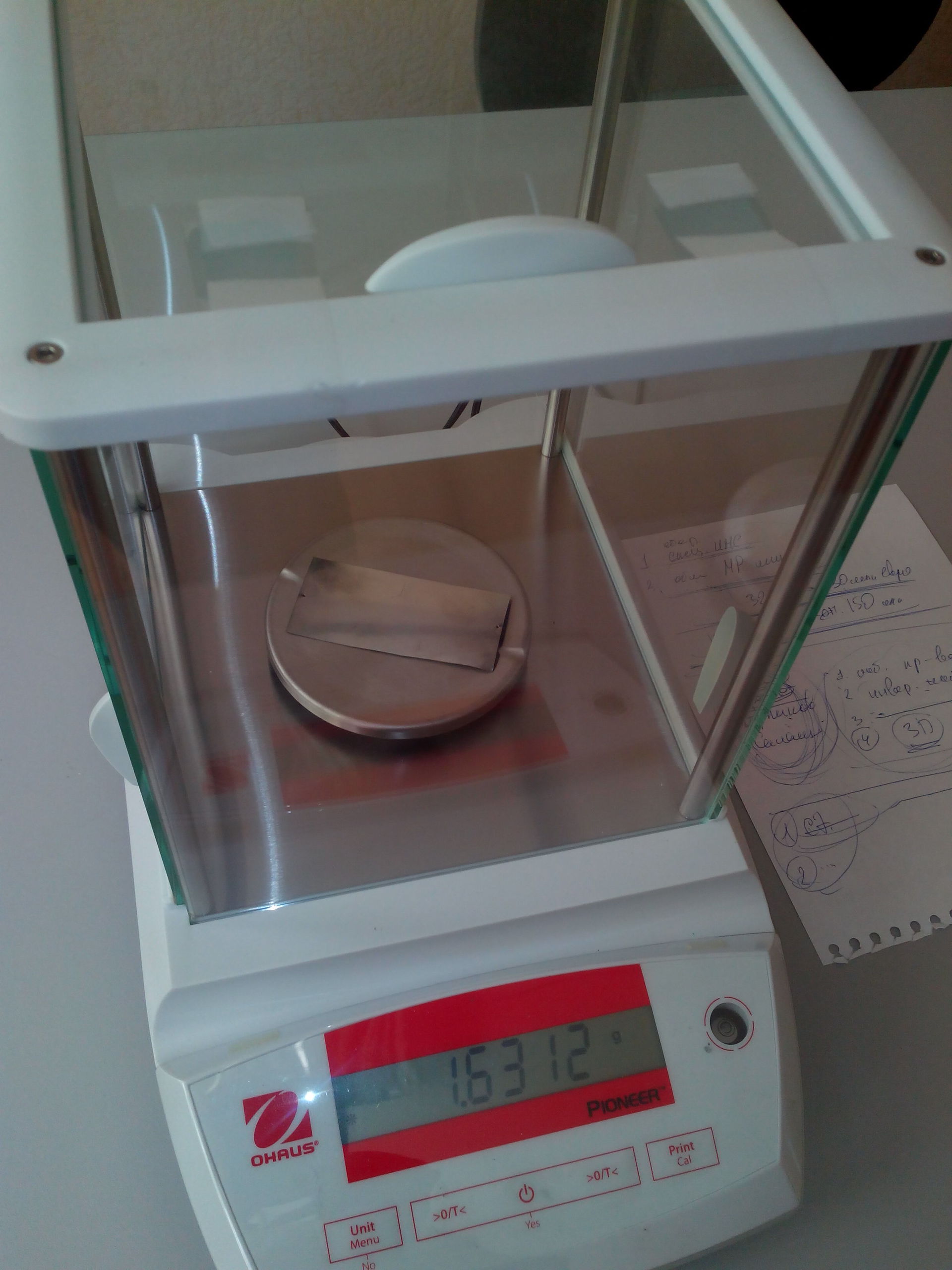
We applied it to various materials: wood, metals, foil, plastics, paper, plastic films, fabrics, in short, everything that could be placed in the chamber and attached to the drum. Basically, we focused on obtaining effects of a decorative nature - a change in color or tactile perception of the surface. On these samples of organic and inorganic origin, you can see the difference in color before and after applying various metal films.

Even more prominently, the color difference before and after spraying is visible on fabrics and films. Here the right piece of ordinary plastic film is not sprayed, and the left is covered with a layer of copper.
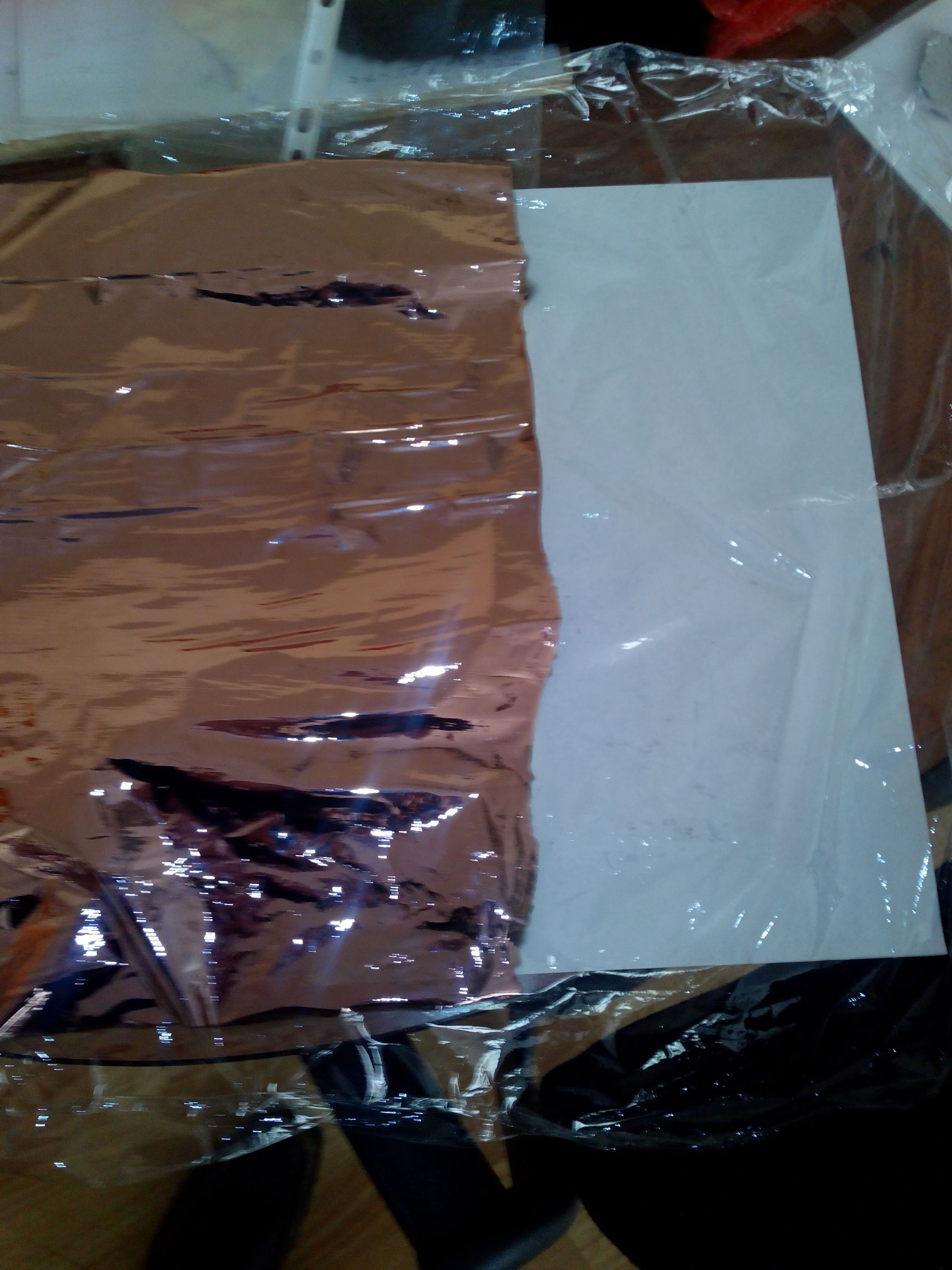
Another effect that can be used for various needs is the conductivity of thin films on substrates. This photo shows the resistance of a piece of paper (in ohms), on which a titanium film is applied a little more than a micron thick.
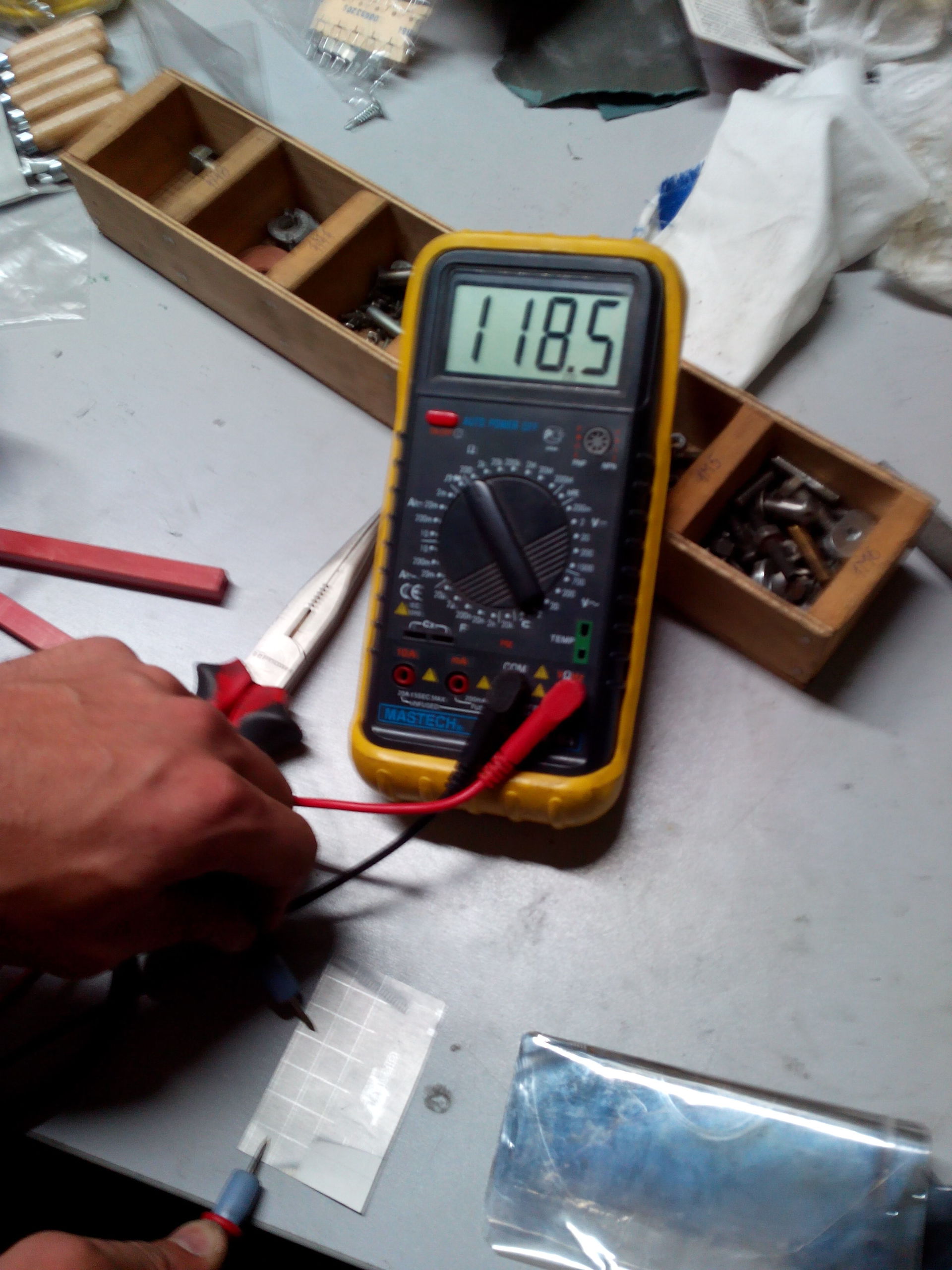
For further development, we have chosen several areas. One of them is to improve the efficiency of film sputtering by magnetrons. We are going to "swing" at our own development and manufacture of a more powerful magnetron with a height of a chamber and a power of 2 times more than that shown in this essay. We also want to test the technology of reactive sputtering, when, for example, oxygen or nitrogen are introduced into the chamber together with a plasma-forming argon gas, and during the sputtering of the films, not purely metallic films are formed on the surface of the substrate, but oxides or nitrides that have a different spectrum of properties than pure metal films.
Since we have passed a relatively completed stage in the development of the technology of vacuum deposition of thin films, I logically had the idea to share my experience with you. Of course, it may seem to you that there was little that lay at the very forefront of science and technology in this movement. However, in our opinion, the experience gained may be useful.

So, the story began a little earlier, when we got a vacuum chamber. Her path to us was not close and can be described in a separate story, but this, as they say, is "a completely different story." I can only say that even earlier it brought people some benefit in one of the laboratories of the University of Gottingen.
The first thing we started to operate the vacuum chamber on was the testing of a method of thermal deposition of metals on substrates. The method is simple and old as the world. A molybdenum crucible is used to place a target of a sprayed metal, such as silver. Around it is a heating element. We used a tungsten-frien alloy wire, which was wound in the form of a spiral.
The complete device for thermal spraying is as follows:

Equipment for thermal spraying of metals. but. Assembled (protective shield and valve removed). Designations: 1 - crucible, 2 - heating element, 3 - steam pipe, 4 - current lead, 5 - thermocouple, 6 - frame for the sample.
After passing the current (it goes through the pressure glands to the vacuum chamber), the spiral heats up, heats the boat, in which the target material is also heated and evaporates. A cloud of metal vapor rises through the steam line and envelops the body onto which it is necessary to deposit a metal film.
The method itself is simple and good, but there are also disadvantages: high energy consumption, it is difficult to place surfaces (bodies) in the cloud on which the film needs to be deposited. Adhesion is also not the best. They were applied to various materials, including metals, glass, plastic, etc. Mostly for research purposes, since we only mastered vacuum equipment.
Now it’s the turn to talk about the vacuum system. We conducted the experiments in a vacuum chamber equipped with a vacuum system consisting of a rotary fore-vacuum and turbomolecular pump and providing a residual pressure of 9.5 • 10 -6 - 1.2 • 10 -5 mm Hg.
If at first glance it seems that it is not complicated, then in fact it is not. First, the chamber itself must have the tightness necessary to maintain a high vacuum. This is achieved by sealing all functional flanges and holes. The upper and lower flange-covers have the same, in principle, rubber seals, as well as the smallest openings, designed to install windows, sensors, devices, pressure glands and other flange covers, only with a diameter much larger. For example, to reliably seal such a hole, a

flange, gasket, and fasteners are required, as in this photo.

Here, this sensor measures the vacuum in the chamber, the signal from it enters the device, which shows the level of high vacuum.

A vacuum of the required level (for example, 10-5 mmHg) is achieved as follows. Initially, a low vacuum is pumped out to the level of 10-2 by the forevacuum pump. Upon reaching this level, a high-vacuum pump (turbomolecular) is turned on, the rotor of which can rotate at a speed of 40,000 rpm. At the same time, the fore-vacuum pump continues to work - it pumps out pressure from the turbomolecular pump itself. The latter is a rather capricious aggregate and its “thin” device played a certain role in this story. We use Osaka vacuum Japanese turbomolecular pump.

It is recommended that air pumped out of the chamber with oil vapors be discharged into the atmosphere, as fine droplets of oil can “splash” the entire room.
Having dealt with the vacuum system and having worked out thermal spraying, we decided to try out another way of applying films - magnetron. We had a long experience in communicating with one large laboratory, which applied functional nanocoatings for some of our developments, just by the method of magnetron sputtering. In addition, we have fairly close ties with some departments of MEPhI, MVTU and other universities, which also helped us master this technology.
But over time, we wanted to use more opportunities that the vacuum chamber provides.
Soon we had a small magnetron, which we decided to adapt for applying films.

It is the magnetron vacuum method of deposition of thin metal and ceramic films that is considered one of the most productive, economical and easy to use among all physical methods of deposition: thermal evaporation, magnetron, ion, laser, electron beam. The magnetron is mounted in one of the flanges, as convenient for use. However, this is not enough for spraying, since it requires the supply of a certain voltage, cooling water, and also gases to ensure ignition of the plasma.
Theoretical excursion
Simplified, the magnetron is arranged as follows. On the base, which simultaneously serves as a magnetic circuit, strong magnets are placed that form a strong magnetic field. On the other hand, the magnets are closed by a metal plate, which serves as a source of atomized material and is called a target. Potential is supplied to the magnetron, and earth is supplied to the body of the vacuum chamber. The potential difference formed between the magnetron and the camera body under conditions of a rarefied atmosphere and magnetic field leads to the following. The atom of a plasma-forming argon gas enters the action of the lines of force of the magnetic and electric fields and ionizes under their action. A knocked out electron is attracted to the camera body. A positive ion is attracted to the magnetron target and, having accelerated under the action of magnetic field lines, hits the target, knocking out a particle from it. It flies at an angle opposite to that at which the ion of the argon atom hit the target. A metal particle flies from the target towards the substrate located opposite it, which can be made of any material.

Our university friends manufactured a power source for this DC magnetron with a power of about 500 watts.

We also built a gas inlet system for plasma-forming argon gas.

To place the objects on which the films will be sprayed, we built the following device. There are technological holes in the chamber lid in which various devices can be installed: power pressure glands, motion pressure glands, transparent windows, sensors, etc. In one of these holes we installed a rotary shaft pressure seal. Outside of the camera, we brought rotation from a small electric motor to this shaft. Having established the rotation speed of the drum of the order of 2-5 hertz, we have achieved good uniformity in the deposition of films around the circumference of the drum.

Bottom, i.e. inside the chamber, we mounted on the shaft a light metal basket on which objects can be hung. In a stationery store, such a standard drum is sold as a waste basket and costs about 100 rubles.

Now we had almost everything we needed for spraying films. As targets we used the following metals: copper, titanium, stainless steel, aluminum, copper-chromium alloy.

And they began to dust. Through transparent windows into the chamber, one could observe the glow of plasma on the surface of the magnetron target. So we controlled “by eye” the moment of ignition of the plasma and the intensity of the deposition.

A method for controlling the thickness of the spraying was invented quite simple. The same piece of foil with a measured surface area was placed on the drum and its weight was measured before and after the spraying session. Knowing the density of the sprayed metal, the thickness of the applied coating was easily calculated. The thickness of the coating was controlled either by changing the spraying time, or by adjusting the voltage at the magnetron's power source. This photo shows precision scales that allow you to measure the mass of samples with an accuracy of ten thousandths of a gram.

We applied it to various materials: wood, metals, foil, plastics, paper, plastic films, fabrics, in short, everything that could be placed in the chamber and attached to the drum. Basically, we focused on obtaining effects of a decorative nature - a change in color or tactile perception of the surface. On these samples of organic and inorganic origin, you can see the difference in color before and after applying various metal films.

Even more prominently, the color difference before and after spraying is visible on fabrics and films. Here the right piece of ordinary plastic film is not sprayed, and the left is covered with a layer of copper.

Another effect that can be used for various needs is the conductivity of thin films on substrates. This photo shows the resistance of a piece of paper (in ohms), on which a titanium film is applied a little more than a micron thick.

For further development, we have chosen several areas. One of them is to improve the efficiency of film sputtering by magnetrons. We are going to "swing" at our own development and manufacture of a more powerful magnetron with a height of a chamber and a power of 2 times more than that shown in this essay. We also want to test the technology of reactive sputtering, when, for example, oxygen or nitrogen are introduced into the chamber together with a plasma-forming argon gas, and during the sputtering of the films, not purely metallic films are formed on the surface of the substrate, but oxides or nitrides that have a different spectrum of properties than pure metal films.
